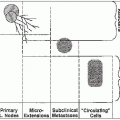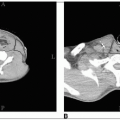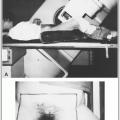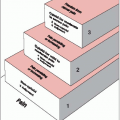The uterus, a hollow muscular organ in the middle of the pelvis, is divided into the corpus, body, and cervix. The most superior portion of the corpus is the fundus.
The uterine cavity is lined by endometrium, which is made of columnar cells.
The muscular layer (myometrium) is composed of smooth muscle fibers.
The peritoneum covers the uterus and forms the broad ligaments laterally.
Carcinoma of the endometrium is the most common gynecologic malignancy (2).
The incidence peaks in the 50- to 70-year age group; 75% of all cases occur in postmenopausal women (7). The National Cancer Institute’s Surveillance, Epidemiology and End Results (SEER) Program estimated there would be 42,160 new cases of endometrial carcinoma (EC) and 7,780 deaths in 2009 (2).
Risk factors for development of endometrial cancer include unopposed estrogen exposure (polycystic ovary or Stein-Leventhal’s syndrome, obesity, nulliparity, exogenous estrogen, estrogen-secreting tumors of the ovaries), late menopause (greater than 52 years of age), tamoxifen use, previous pelvic irradiation, edematous hyperplasia, low parity, diabetes mellitus, and hypertension.
Most endometrial carcinomas are confined to the uterus at the time of diagnosis.
Tumors arising from the endometrium commonly spread into the myometrium and to contiguous areas. Carcinoma of the endometrium may extend directly to the cervix, vagina, parametrial tissue, bladder, or rectum.
Tumor grade and depth of invasion into the myometrium are important prognostic indicators. Deep myometrial invasion is more common with higher-grade tumors.
As tumor grade and depth of myometrial invasion increase, the risk of pelvic and para-aortic lymph node metastases also increases (Table 36-1).
Peritoneal seeding of endometrial cancer may occur because an endometrial lesion may penetrate the uterine wall or seed transtubally. This is most common with papillary serous or clear-cell histologies.
Hematogenous metastases are infrequent at presentation but are seen in end-stage patients.
TABLE 36-1 Grade, Depth of Invasion, and Metastases in Endometrial Carcinoma | ||||||||||||||||||||||||||||||||||||||||||||||||||||||||
|---|---|---|---|---|---|---|---|---|---|---|---|---|---|---|---|---|---|---|---|---|---|---|---|---|---|---|---|---|---|---|---|---|---|---|---|---|---|---|---|---|---|---|---|---|---|---|---|---|---|---|---|---|---|---|---|---|
| ||||||||||||||||||||||||||||||||||||||||||||||||||||||||
The most common presenting symptom is vaginal bleeding, which is reported by 75% of patients. Back pain and pressure symptoms on bowel and bladder caused by the enlarged uterus may occur.
Physical findings are usually minimal; blood in the vagina emanating from the cervical os is the most common finding.
No satisfactory screening method is available for detecting endometrial carcinoma in symptomatic patients.
The Papanicolaou (Pap) smear detects only approximately 40% of endometrial tumors.
Endometrial biopsy or aspiration curettage is indicated in postmenopausal women with vaginal bleeding or perimenopausal women with menstrual abnormalities, and obviates, in most cases, the need for dilation and curettage.
Fractional dilation and curettage and cervical biopsy are indicated when there is a high degree of suspicion of cancer and diagnosis cannot be made by endometrial biopsy or aspiration curettage.
Diagnostic studies routinely used in the clinical staging of patients with endometrial cancer vary with stage (Table 36-2).
Computed tomography (CT) of the pelvis and abdomen is recommended for all patients with high-grade tumors or with stage II or higher disease to detect possible nodal or extrauterine spread of cancer.
Magnetic resonance imaging (MRI) is not helpful in detecting nodal or peritoneal spread; however, it is useful in demonstrating the depth of myometrial invasion, with an accuracy of approximately 80% (7).
Ultrasound may be used to assess thickness of the myometrium.
The tumor marker CA 125 is elevated in 59% of patients with advanced or recurrent endometrial carcinoma; however, the marker is not specific (21).
Endometrial carcinoma is most commonly surgically staged according to the guidelines of the International Federation of Gynecology and Obstetrics. Table 36-3 presents the FIGO staging system alongside the new AJCC (7th edition) TNM definitions.
For inoperable patients, the International Federation of Gynecology and Obstetrics clinical staging system, which is based on bimanual pelvic examination under anesthesia and on the diagnostic procedures previously discussed, is recommended.
TABLE 36-2 Diagnostic Workup for Endometrial Cancer | ||||||||||||||||||||||||||||||||
|---|---|---|---|---|---|---|---|---|---|---|---|---|---|---|---|---|---|---|---|---|---|---|---|---|---|---|---|---|---|---|---|---|
| ||||||||||||||||||||||||||||||||
Endometrioid adenocarcinoma is the most common form of carcinoma of the endometrium, accounting for 75% to 80% of cases.
Endometrioid adenocarcinoma is divided into four subtypes: papillary, secretory, ciliated cells, and adenocarcinoma with squamous differentiation.
Various pathologic classifications of endometrial cancer are shown in Table 36-4.
Serous, clear-cell, and pure squamous cell carcinomas are the most aggressive cancers arising from the endometrium.
The most significant prognostic factor is the clinical or pathologic stage.
The histologic grade of the tumor and depth of myometrial invasion by the tumor have an impact on the incidence of lymph node involvement and on prognosis (8, 9) (Table 36-1).
The presence of lymphovascular involvement (LVI) significantly increases the risk of tumor recurrence after surgery.
Age at the time of diagnosis is an important prognostic factor. Older patients have a higher chance of myometrial involvement and advanced stage and a lower 5-year survival rate.
Management guidelines for endometrial carcinoma are summarized in Tables 36-5 and 36-6.
TABLE 36-3 American Joint Committee on Cancer (AJCC) and International Federation of Gynecology and Obstetrics Corpus Uteri Cancer Staging | |||||||||||||||||||||||||||||||||||||||
|---|---|---|---|---|---|---|---|---|---|---|---|---|---|---|---|---|---|---|---|---|---|---|---|---|---|---|---|---|---|---|---|---|---|---|---|---|---|---|---|
| |||||||||||||||||||||||||||||||||||||||









